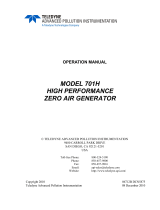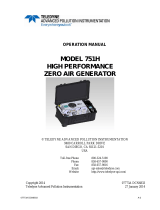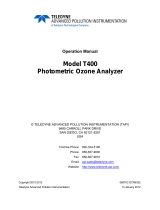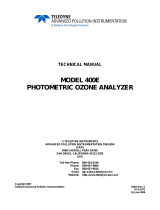Page is loading ...

OPERATION MANUAL
MODEL 701
ZERO AIR GENERATOR
TELEDYNE
ADVANCED POLLUTION INSTRUMENTATION DIVISION
(TAPI)
9480 CARROLL PARK DRIVE
SAN DIEGO, CA 92121-5201
TOLL-FREE: 800-324-5190
FAX: 858-657-9816
TEL: 858-657-9800
E-MAIL: [email protected]
WEB SITE: www.teledyne-api.com
01671H DCN6051
Copyright 2007 – 2011 Teledyne Advanced Pollution Instrumentation
08 April 2011


01671H (DCN6051) i
ABOUT THIS MANUAL
This M701 Zero Air Generator operation manual is comprised of multiple documents as
listed below.
Part No. Rev Name/Description
01671 H Operation Manual
02052 M List, Spare Parts (in Appendix A) with Sales for most recent version.
06172 C List, Recommended Spares Stocking Levels (RSSL), (in Appendix A)
06477 B Level I Spares Kit (in Appendix A)
06619 B Schematic, Controller Board (in Appendix B)
NOTE
We recommend that this manual be read in its entirety before any attempt
is made to operate the instrument.

ii 01671H (DCN6051)
REVISION HISTORY
M701 Manual 01671
2011 April 8, Rev H, per DCN 6051
Document P/N Rev DCN Change Summary
Operation Manual 01671 H 6051
Correct name in title: from “…Module” to
“…Generator”
2010 November 5 , Rev G, per DCN 5875
Document P/N Rev DCN Change Summary
Operation Manual 01671 G 5875
Replaced pressure switch with pressure
sensor.
Replaced controller with new.
Updated hydrocarbon scrubber content.
Added Section on Electro-static Discharge
List, Spare Parts 02052 M 5895 Updated
List, RSSL 06172 C 5895 Updated
Level I Spares Kit 06477 B 5895 Updated
Schematic, Controller Board 06619 B 5874 New; replaces 04285
(The following list captures the construct of this manual with its initial Revision History section).
2010 January 20, Rev F, per DCN 5630:
Document P/N Rev DCN Change Summary
Schematic, Controller w/DewPt 04285 C n/a current Rev for manual’s initial release
List, Spare Parts 02052 L n/a current Rev for this manual’s initial release
List, RSSL 06172 B n/a current Rev for this manual’s initial release
Level 1 Spares Kit 06477 A n/a current Rev for this manual’s initial release
Expendables Kit 01598 A n/a current Rev for this manual’s initial release

01671H (DCN6051) iii
SAFETY MESSAGES
Important safety messages are provided throughout this manual for the purpose of avoiding personal
injury or instrument damage. Please read these messages carefully. Each safety message is associated
with a safety alert symbol, and are placed throughout this manual and inside the instrument. The symbols
with messages are defined as follows:
WARNING: Electrical Shock Hazard
HAZARD: Strong oxidizer
GENERAL WARNING/CAUTION: Read the accompanying message for specific
information.
CAUTION: Hot Surface Warning
Do Not Touch: Touching some parts of the instrument without protection or proper tools
could result in damage to the part(s) and/or the instrument.
Technician Symbol: All operations marked with this symbol are to be performed by
qualified maintenance personnel only.
Electrical Ground: This symbol inside the instrument marks the central safety grounding
point for the instrument.
CAUTION
This instrument should only be used for the purpose and in the manner described in
this manual. If you use this instrument in a manner other than that for which it was
intended, unpredictable behavior could ensue with possible hazardous consequences
.
NEVER use any gas analyzer to sample combustible gas(es)!
Note
For Technical Assistance regarding the use and maintenance of this instrument or any other
Teledyne API product, contact Teledyne API’s Customer Service Department:
Telephone: 800-324-5190
Email: [email protected]
or access any of the service options on our website at http://www.teledyne-api.com/

iv 01671H (DCN6051)
CONSIGNES DE SÉCURITÉ
Des consignes de sécurité importantes sont fournies tout au long du présent manuel dans le
but d’éviter des blessures corporelles ou d’endommager les instruments. Veuillez lire
attentivement ces consignes. Chaque consigne de sécurité est représentée par un
pictogramme d’alerte de sécurité; ces pictogrammes se retrouvent dans ce manuel et à
l’intérieur des instruments. Les symboles correspondent aux consignes suivantes :
AVERTISSEMENT : Risque de choc électrique
DANGER : Oxydant puissant
AVERTISSEMENT GÉNÉRAL / MISE EN GARDE : Lire la consigne
complémentaire pour des renseignements spécifiques
MISE EN GARDE : Surface chaude
Ne pas toucher : Toucher à certaines parties de l’instrument sans
protection ou sans les outils appropriés pourrait entraîner des
dommages aux pièces ou à l’instrument.
Pictogramme « technicien » : Toutes les opérations portant ce
symbole doivent être effectuées uniquement par du personnel de
maintenance qualifié.
Mise à la terre : Ce symbole à l’intérieur de l’instrument détermine le
point central de la mise à la terre sécuritaire de l’instrument.
MISE EN GARDE
Cet instrument doit être utilisé aux fins décrites et de la manière
décrite dans ce manuel. Si vous utilisez cet instrument d’une
autre manière que celle pour laquelle il a été prévu, l’instrument
pourrait se comporter de façon imprévisible et entraîner des
conséquences dangereuses.
NE JAMAIS utiliser un analyseur de gaz pour échantillonner des
gaz combustibles!

01671H (DCN6051) v
TABLE OF CONTENTS
TABLE OF CONTENTS ..................................................................................V
LIST OF FIGURES ........................................................................................VII
LIST OF TABLES..........................................................................................VII
1 INTRODUCTION .......................................................................................1-1
1.1 PREFACE ...................................................................................................................1-1
1.2 USING THIS MANUAL ..................................................................................................1-2
2 SPECIFICATIONS AND WARRANTY ......................................................2-1
2.1 SPECIFICATIONS......................................................................................................... 2-1
2.2 WARRANTY ................................................................................................................2-2
3 GETTING STARTED.................................................................................3-1
3.1 UNPACKING ............................................................................................................... 3-1
3.2 INSTALLATION ............................................................................................................3-1
3.3 FRONT AND REAR PANELS ..........................................................................................3-3
3.4 ELECTRICAL AND PNEUMATIC CONNECTIONS................................................................3-4
3.5 POWER-UP ................................................................................................................ 3-5
3.6 SHUT DOWN, STORAGE AND TRANSPORTATION ............................................................ 3-5
4 OPTIONAL HARDWARE AND SOFTWARE............................................4-1
4.1 CO SCRUBBER (OPT 1B)........................................................................................... 4-1
4.2 HYDROCARBON SCRUBBER (OPT 2B) ......................................................................... 4-1
4.3 CARRYING STRAP/HANDLE (OPT 29) .......................................................................... 4-2
4.4 RACK MOUNT KITS (OPT 20A, OPT 20B & OPT 21) ................................................... 4-3
4.5
EXPENDABLE KITS (OPT 42A) .................................................................................... 4-3
4.6 FLOW RESTRICTION (13 SLPM) (OPT 72B) ................................................................ 4-3
4.7
DEWPOINT SENSOR (OPT 86E) ..................................................................................4-3
5 OPERATION .............................................................................................5-1
5.1 OVERVIEW .................................................................................................................5-1
5.2 COMPRESSOR............................................................................................................ 5-6
5.3
COOLING COIL ........................................................................................................... 5-6
5.4 WATER TRAP .............................................................................................................5-6
5.5 WATER DRAIN VALVE ................................................................................................. 5-6
5.6
PRESSURE RELIEF VALVE ...........................................................................................5-7
5.7
REGENERATIVE DRYER ............................................................................................... 5-7
5.8 CHECK VALVE ............................................................................................................5-7
5.9
STORAGE TANK..........................................................................................................5-8
5.10
PRESSURE SENSOR.................................................................................................. 5-8

vi 01671H (DCN6051)
5.11 PRESSURE REGULATOR ............................................................................................ 5-8
5.12 PRESSURE GAUGE ...................................................................................................5-9
5.13 HYDROCARBON SCRUBBER (OPTION) .........................................................................5-9
5.14
CO SCRUBBER (OPTION) ........................................................................................5-10
5.15
NO SCRUBBER ...................................................................................................... 5-10
5.16 CHARCOAL SCRUBBER............................................................................................ 5-10
5.17 FINAL FILTER ......................................................................................................... 5-10
5.18 CONTROLLER ......................................................................................................... 5-10
6 MAINTENANCE ........................................................................................6-1
6.1 SCHEDULE.................................................................................................................6-1
6.2 CLEANING..................................................................................................................6-1
6.3 CHECKING THE TUBING...............................................................................................6-2
6.4 REPLACING THE CHARCOAL SCRUBBER ....................................................................... 6-3
6.5 REPLACING THE NO - NO
2
SCRUBBER ........................................................................ 6-3
6.6 REPLACING THE CO - CO
2
SCRUBBER ........................................................................ 6-4
6.7 REPLACING THE HC SCRUBBER .................................................................................. 6-5
6.8 SERVICING THE REGENERATIVE DRYER .......................................................................6-6
6.9 CHANGING THE 4-WAY VALVE (IN THE REGENERATIVE DRYER)..................................... 6-9
6.10 REPLACING THE SHUTTLE VALVE (IN THE REGENERATIVE DRYER)............................... 6-9
6.11 LEAK CHECK ............................................................................................................ 6-9
6.12 PARTICULATE FILTER ELEMENT REPLACEMENT......................................................... 6-10
7 TROUBLESHOOTING ..............................................................................7-1
8 A PRIMER ON ELECTRO-STATIC DISCHARGE ....................................8-1
8.1 HOW STATIC CHARGES ARE CREATED ......................................................................... 8-1
8.2 HOW ELECTRO-STATIC CHARGES CAUSE DAMAGE ....................................................... 8-2
8.3 COMMON MYTHS ABOUT ESD DAMAGE ....................................................................... 8-3
8.4 BASIC PRINCIPLES OF STATIC CONTROL....................................................................... 8-4
8.4.1 General Rules
....................................................................................................8-4
8.5
BASIC ANTI-ESD PROCEDURES FOR ANALYZER REPAIR AND MAINTENANCE ................... 8-5
8.5.1 Working at the Instrument Rack
........................................................................ 8-5
8.5.2 Working at an Anti-ESD Work Bench ................................................................ 8-6
8.5.3 Transferring Components from
Rack to Bench and Back.................................. 8-6
8.5.4 Opening Shipments from Teledyne API’
s Customer Service............................. 8-7
8.5.5 Packing Components for Return to Teledyne API’s Customer Service ............. 8-8
APPENDIX A – Spare Parts A-1
APPENDIX B – Schematics B-1

01671H (DCN6051) vii
LIST OF FIGURES
FIGURE 3-1: DIMENSIONS......................................................................................................................... 3-2
FIGURE 3-2: FRONT PANEL ...................................................................................................................... 3-3
F
IGURE 3-3: REAR PANEL ........................................................................................................................ 3-3
F
IGURE 4-1: CARRYING STRAP HANDLE AND RACK MOUNT BRACKETS ................................................. 4-2
FIGURE 5-1: M701 PNEUMATIC DIAGRAM WITH HC/CO AND DEW POINT SENSOR OPTIONS .................. 5-3
FIGURE 5-2: M701 PNEUMATIC DIAGRAM WITH CO AND DEW POINT SENSOR OPTIONS......................... 5-4
FIGURE 5-3: INTERNAL CHASSIS LAYOUT, PLAN VIEW............................................................................ 5-5
FIGURE 5-4: CONTROL BOARD LAYOUT................................................................................................. 5-12
F
IGURE 6-1: REGENERATIVE DRYER ........................................................................................................ 6-8
F
IGURE 8-1: TRIBOELECTRIC CHARGING.................................................................................................. 8-1
FIGURE 8-2: BASIC ANTI-ESD WORK STATION........................................................................................ 8-4
LIST OF TABLES
TABLE 2-1. SPECIFICATIONS .................................................................................................................... 2-1
TABLE 6-1. MAINTENANCE SCHEDULE .................................................................................................... 6-1
TABLE 8-1. STATIC GENERATION VOLTAGES FOR TYPICAL ACTIVITIES .................................................. 8-2
TABLE 8-2. SENSITIVITY OF ELECTRONIC DEVICES TO DAMAGE BY ESD................................................ 8-2

viii 01671H (DCN6051)
This page intentionally left blank.

01671H (DCN6051) 1-1
1 INTRODUCTION
1.1 Preface
Teledyne API is pleased that you have purchased the Model 701 (or M701) Zero Air
System.
The M701 is an excellent source of clean, dry air for dilution calibrators. It also may be
used as a source of purge air for permeation tube ovens or burner air for FID analyzers.
The regenerative, heatless dryer removes water and produces gas with a dewpoint of
less than -20°C (up to 15 SLPM flow rate) independent of the inlet dewpoint and assists
in the removal of other gases, greatly increasing the life of the chemical scrubbers.
The basic M701 includes an oil and diaphragm free pump plus scrubbers to remove
SO
2
, NO, NO
2
, O
3
and H
2
S. Optional high performance scrubbers are available to
remove CO and Hydrocarbons.
Inlet air is pulled into the pump and routed through a pre-cooler and water trap to
remove moisture. The air then passes through the Regenerative Dryer for final drying
and then to the storage tank.
Tank pressure is monitored and maintained at a preset level by cycling the pump
automatically as needed, thereby extending both the pump and scrubber life. Outlet air
then passes through a filter to assure a clean, dry, analytical zero air supply.
A microcontroller cycles the regenerative dryer and water trap valves to prevent the
pump from starting against full head pressure. The M701 is an ideal accessory to the
Model 700E Mass Flow Calibrator or Model 702 Single Point Calibrator as a zero air
source for analyzers.
M701 Features:
Standard two year warranty
Regenerative, heatless dryer for maintenance-free water removal
independent of inlet dewpoint
Long life scrubbers for SO
2
, NO, NO
2
, O
3
, and H
2
S
Optional CO or CO and Hydrocarbon scrubber
Automatic water drain
Automatic pump control based on flow demand
May be used to provide combustion air for FID (with HC Scrubber option)
Source of purge air for permeation tube ovens
Zero air for Ozone Generators

INTRODUCTION
Teledyne API Model 701 Zero Air Generator
1-2 01671H (DCN6051)
1.2 Using This Manual
This manual has the following data structures:
TABLE OF CONTENTS
Outlines the contents of the manual in the order the information is presented. This is a
good overview of the topics covered in the manual. There is also a list of tables, a list of
figures and a list of appendices. In the electronic version of the manual, clicking on any
of these table entries automatically views that section.
1.0 INTRODUCTION
A brief description of the M701 architecture, as well as a description of the layout of the
manual and what information is located in its various sections and chapters.
2.0 SPECIFICATIONS AND WARRANTY
This section contains a list of the monitor’s performance specifications, a description of
the conditions and configuration under which Teledyne API’s warranty statement
applies.
3.0 GETTING STARTED
A concise set of instructions for setting up, installing and starting your monitor for the
first time. This includes unpacking; mechanical installation; attaching all pneumatic lines;
attaching all electrical and electronic connections.
4.0 OPTIONAL HARDWARE & SOFTWARE
A description of optional equipment to add functionality to your instrument.
5.0 OPERATION INSTRUCTIONS
Instructions for operating the monitor and using its basic features and functions.
6.0 MAINTENANCE
Description of certain preventative maintenance procedures that should be regularly
performed on your instrument to keep it in good operating condition.
7.0 TROUBLESHOOTING
This section includes pointers and instructions for diagnosing problems with the
instrument, as well as instructions on performing repairs or replacing components on
the instrument.

01671H (DCN6051) 2-1
2 SPECIFICATIONS AND WARRANTY
2.1 Specifications
Table 2-1. Specifications
PARAMETER SPECIFICATION
Output STD 20 SLPM @ 30 psig
Max delivery pressure 35 psig
(Except in some specials that have restricted output)
Dewpoint
< 15 SLPM
15 SLPM
< -20C
< -10C
SO
2
<0.5 ppb
NO <0.5 ppb
NO
2
<0.5 ppb
O
3
<0.5 ppb
HC/CO Options < 0.02 ppm HC / < 0.025 ppm CO
Purge air As required by the calibrator
Compressor Single-cylinder, internal
Mounting Bench type (standard)
Rack mount (optional)
Dimensions 8.75” H x 17”W x 23.5”D
(22.2 cm x 43.2 cm x 60 cm)
Weight 55 lbs. (25 Kg)
Operating Temp
5-40C
Power 115V, 60Hz, 3.5A
230V, 50Hz, 2.0A
220V, 60 Hz, 2.2A
Environmental
Conditions
Installation Category
(Over Voltage Category ) II
Pollution Degree 2

SPECIFICATIONS and WARRANTY
Teledyne API Model 701 Zero Air Generator
2-2 01671H (DCN6051)
2.2 Warranty
WARRANTY POLICY (02024D) (DCN 4473)
Prior to shipment, Teledyne API equipment is thoroughly inspected and tested. Should equipment failure
occur, Teledyne API assures its customers that prompt service and support will be available.
COVERAGE
After the warranty period and throughout the equipment lifetime, Teledyne API stands ready to provide
on-site or in-plant service at reasonable rates similar to those of other manufacturers in the industry. All
maintenance and the first level of field troubleshooting are to be performed by the customer.
NON-TELEDYNE API MANUFACTURED EQUIPMENT
Equipment provided but not manufactured by Teledyne API is warranted and will be repaired to the extent
and according to the current terms and conditions of the respective equipment manufacturer’s warranty.
GENERAL
During the warranty period, T-API warrants each Product manufactured by T-API to be free from defects
in material and workmanship under normal use and service. Expendable parts are excluded.
If a Product fails to conform to its specifications within the warranty period, Teledyne API shall correct
such defect by, at Teledyne API's discretion, repairing or replacing such defective Product or refunding
the purchase price of such Product.
The warranties set forth in this section shall be of no force or effect with respect to any Product: (i) that
has been altered or subjected to misuse, negligence or accident, or (ii) that has been used in any manner
other than in accordance with the instruction provided by Teledyne API or (iii) not properly maintained.
THE WARRANTIES SET FORTH IN THIS SECTION AND THE REMEDIES THEREFORE ARE
EXCLUSIVE AND IN LIEU OF ANY IMPLIED WARRANTIES OF MERCHANTABILITY, FITNESS FOR
PARTICULAR PURPOSE OR OTHER WARRANTY OF QUALITY, WHETHER EXPRESSED OR
IMPLIED. THE REMEDIES SET FORTH IN THIS SECTION ARE THE EXCLUSIVE REMEDIES FOR
BREACH OF ANY WARRANTY CONTAINED HEREIN. TELEDYNE API SHALL NOT BE LIABLE FOR
ANY INCIDENTAL OR CONSEQUENTIAL DAMAGES ARISING OUT OF OR RELATED TO THIS
AGREEMENT OF TELEDYNE API'S PERFORMANCE HEREUNDER, WHETHER FOR BREACH OF
WARRANTY OR OTHERWISE.
TERMS AND CONDITIONS
All units or components returned to Teledyne API should be properly packed for handling and returned
freight prepaid to the nearest designated Service Center. After the repair, the equipment will be returned,
freight prepaid.
CAUTION – Avoid Warranty Invalidation
Failure to comply with proper anti-Electro-Static Discharge (ESD) handling and
packing instructions and Return Merchandise Authorization (RMA) procedures when
returning parts for repair or calibration may void your warranty. For anti-ESD handling
and packing instructions please refer to “Packing Components for Return to Teledyne
API’s Customer Service” in the Primer on Electro-Static Discharge section of this
manual, and for RMA procedures please refer to our Website at
http://www.teledyne-api.com under Customer Support > Return Authorization.

01671H (DCN6051) 3-1
3 GETTING STARTED
3.1 Unpacking
CAUTION
To avoid personal injury, always use two persons to lift and
carry the Model 701
1. Verify that there is no shipping damage. If there are signs of damage, immediately
advise the shipper, then Teledyne API.
2. Remove the M701 from its shipping carton.
3. Remove the cover and check for damage inside.
4. Remove the four red shipping screws holding the compressor base to the bottom of
the chassis. These screws are inside the chassis at the bottom, underneath the
pump. See Figure 5-3.
5. Check the line voltage and frequency label on the rear panel and verify that it
matches your local power.
3.2 Installation
See Figure 3-1.
The basic M701 has rubber feet for counter-top use. Optionally, the M701 is supplied
with slides and angles for mounting in a standard 19” RETMA rack.
When installing the M701, check the following points:
1. At least 6” (150 mm) clearance at the back for proper fan operation.
2. At least 3” (75 mm) at each side for proper venting.
3. Adequate support for the weight; 55 lb. (25 kg.).
4. Access at the rear for making the pneumatic and electrical connections.
5. Access at the front for occasional scrubber replacement.
6. For safety, the M701 should be operated with the cover on.

GETTING STARTED
Teledyne API Model 701 Zero Air Generator
3-2 01671H (DCN6051)
Figure 3-1: Dimensions

GETTING STARTED
Teledyne API Model 701 Zero Air Generator
3-4 01671H (DCN6051)
3.4 Electrical And Pneumatic Connections
All connections, electric and pneumatic, are made at the rear panel (Figure 3-3).
NOTE
To maintain compliance with EMC standards, it is required that the cable length be
no greater than 3 meters for all I/O connections, which include Analog In, Analog
Out, Status Out, Control In, Ethernet/LAN, USB, RS-232, and RS-485.
Make the following pneumatic connections:
1. “AIR IN” (1/4” female pipe thread):
Screw the inlet filter into the “AIR IN” port. Hand-tight is OK.
NOTE
Operation without the filter will cause premature pump wear.
2. “DRAIN” (1/4” swage-type bulkhead union):
Connect 1/4” diameter tubing to the water DRAIN fitting to conduct the occasional
spurts of water away from the instrument rack. Connect the tubing to a drain or,
alternatively, the water may be collected in a tray or bucket and dispersed by normal
evaporation
3. “ZERO AIR OUT” (1/4” swage-type bulkhead union):
a. Connect the ZERO AIR OUT port of the M701 to the INLET fitting of the Model
700 Calibrator with CLEAN 1/4” TFE tubing. The pressure in this line will normally
be 30 PSIG, but may be as high as 80 psig.
b. Keep this line as short as possible to minimize pressure drops.
4. “POWER”:
Connect the power cord to the proper power source.
At 115 VAC, 60 Hz, the M701 draws 3.5 Amps.
At 230 VAC, 50 Hz, the M701 draws 2.0 Amps.
.
WARNING
Be sure that the power cord is properly grounded
5. “COOLING FAN”:
The rear panel cooling fan draws air IN and requires at least 6” (150 mm) of
clearance for proper operation.

Teledyne API Model M701 Zero Air Generator
GETTING STARTED
01671H (DCN6051) 3-5
3.5 Power-Up
1. Turn on the front panel POWER SWITCH. SeeFigure 3-2.
2. The front panel power indicator should light.
3. The cooling fan should start immediately.
4. The compressor should start after a few seconds delay. The delay is to allow the
control board to measure the local line frequency.
5. After 30 to 60 seconds, the front panel pressure gauge should read 30 psig.
The Model 701 is now producing clean, dry air.
If the M701 has been unused for several days, it may take 30-60 minutes to achieve
final purity and dryness. It is recommended that the procedure for extended disuse be
followed (Section 3.6, Shut Down, Storage and Transportation).
3.6 Shut Down, Storage and Transportation
Remember that the M701 supplies air on demand.
If the application is not requiring zero air, the compressor will increase the pressure in
the storage tank until the “cut-out” pressure is reached and the pressure sensor signals
the control PCA to turn off the compressor.
The pressure in the storage tank will slowly subside as air is used by the Regenerative
Dryer until the “cut-in” pressure is reached and the pressure sensor signals the control
PCA to turn the compressor on again.
Standing H
2
0 will cause corrosion, so if the M701 is to be out-of-use for an extended
period or if it will be transported, the following procedure is recommended.
1. Turn OFF the M701.
2. Wait approximately 1 minute.
3. Turn the M701 ON and vent any accumulated water through the water drain.
4. Turn the M701 OFF.
This procedure will vent any water that has accumulated in the coalescing filter, which
not only helps to avoid corrosion, but also prevents that water from passing into the
M701 in the event that the instrument is inverted during storage or transportation.

GETTING STARTED
Teledyne API Model 701 Zero Air Generator
3-6 01671H (DCN6051)
This page intentionally left blank.
/











